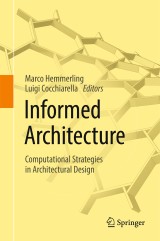Details

Informed Architecture
Computational Strategies in Architectural Design|
149,79 € |
|
| Verlag: | Springer |
| Format: | |
| Veröffentl.: | 19.07.2017 |
| ISBN/EAN: | 9783319531359 |
| Sprache: | englisch |
Dieses eBook enthält ein Wasserzeichen.
Beschreibungen
<p>This book connects the different topics and professions involved in information technology approaches to architectural design, ranging from computer-aided design, building information modeling and programming to simulation, digital representation, augmented and virtual reality, digital fabrication and physical computation. The contributions include experts’ academic and practical experiences and findings in research and advanced applications, covering the fields of architecture, engineering, design and mathematics. </p> What are the conditions, constraints and opportunities of this digital revolution for architecture? How do processes change and influence the result? What does it mean for the collaboration and roles of the partners involved. And last but not least: how does academia reflect and shape this development and what does the future hold? Following the sequence of architectural production - from design to fabrication and construction up to the operation of buildings - thebook discusses the impact of computational methods and technologies and its consequences for the education of future architects and designers. It offers detailed insights into the processes involved and considers them in the context of our technical, historical, social and cultural environment. Intended mainly for academic researchers, the book is also of interest to master’s level students.<p></p>
<div>1. Introduction.- 2. Papers.- 3. Case Studies.- 4. Appendix.</div><div><br/></div>
<p><b>Luigi Cocchiarella</b> (1965), architect, PhD, is associate professor at the Milan Polytechnic University, Department of Architecture and Urban Studies, School of Architecture Urban Planning Construction Engineering.<br/>His research and educational interests focus on architectural representation and visual education in relation to the design processes, and particularly on descriptive and projective geometry and their nexus with art, science, techniques, eidomatics.<br/>He is member of the International Society for Geometry and Graphics (ISGG), the World Academy of Art and Science (WAAS), the Unione Italiana Disegno (UID), the Istituto Lombardo Accademia di Scienze e Lettere, and the Istituto di Studi Superiori dell’Insubria “Gerolamo Cardano”.<br/>In 2015 he published with Springer the three volumes The Visual Language of Techniques Between Science and Art, inspired by the homonymous cycle of seminars he organized for the 150th anniversary of the Politecnico di Milano.</p><p><b>Mar</b></p>co Hemmerling (1970), architect, is a professor of computational design in architecture at the Cologne University of Applied Sciences and visiting professor at the Milan Polytechnic University. Previously he was a professor at the Detmold School of Architecture and Interior Architecture and director of the post-graduate master’s program Computational Design and Construction at the East Westphalia University of Applied Sciences.<br/>He established his Studio for Spatial Design in Cologne after spending several years gaining experience in internationally renowned architectural practices, like the Dutch firm UNStudio, where he was jointly responsible for the design of the Mercedes-Benz Museum in Stuttgart. He studied Architecture and Media Management at the Bauhaus University in Weimar, the Milan Polytechnic University and the Bochum University of Applied Sciences. He is an elected member of the Association of German Architects and the German Association of Craftsmen.<p></p><p></p></p>
<p>This book connects the different topics and professions involved in information technology approaches to architectural design, ranging from computer-aided design, building information modeling and programming to simulation, digital representation, augmented and virtual reality, digital fabrication and physical computation. The contributions include experts’ academic and practical experiences and findings in research and advanced applications, covering the fields of architecture, engineering, design and mathematics. </p> What are the conditions, constraints and opportunities of this digital revolution for architecture? How do processes change and influence the result? What does it mean for the collaboration and roles of the partners involved. And last but not least: how does academia reflect and shape this development and what does the future hold? Following the sequence of architectural production - from design to fabrication and construction up to the operation of buildings - thebook discusses the impact of computational methods and technologies and its consequences for the education of future architects and designers. It offers detailed insights into the processes involved and considers them in the context of our technical, historical, social and cultural environment. Intended mainly for academic researchers, the book is also of interest to master’s level students.<p></p>
Offers an integrative and process-oriented perspective on information technology in architecture Explores design through representation modes Provides additional material (3D-models, videos etc.) Includes supplementary material: sn.pub/extras

















